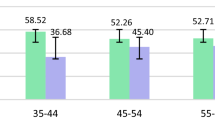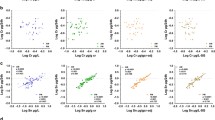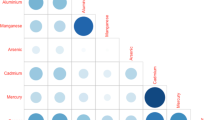Abstract
Background and objectives
The particularly high rate of urbanization in Kinshasa (Democratic Republic of Congo) is associated with environmental degradation. Outdoor and indoor air pollution, as well as water pollution and waste accumulation, are issues of major concern. However, little documented information exists on the nature and extent of this pollution. A biomonitoring study was conducted to document exposure to trace elements in a representative sample of the population in Kinshasa.
Methods
Fifteen trace elements were measured by ICP-MS, CV-AAS, or HG-AFS in spot urine samples from 220 individuals (50.5% women) aged 6–70 years living in the urban area and from 50 additional subjects from the rural area of Kinshasa. Data were compiled as geometric means and selected percentiles, expressed without (μg/L) or with creatinine adjustment (μg/g cr).
Results
Overall, living in urban Kinshasa was associated with elevated levels of several parameters in urine as compared to the population living in the rural area (Asi, Ba, Cd, Cr, and V) as well as compared to an urban population of the southeast of Congo (Al, As, Cd, Cr, Cu, Pb, Mn, Ni, Se, V, and Zn). Elevated levels were also found by comparison with the reference values in databases involving American, Canadian, French, or German populations.
Conclusions
This study provides the first biomonitoring database in the population of Kinshasa, revealing elevated levels for most urinary TE as compared to other databases. Toxicologically relevant elements such as Al, As, Cd, Pb, and Hg reach levels of public health concern.
Similar content being viewed by others
References
Africa Rice Center (2007) Africa rice trends: overview of recent developments in the sub-Saharan Africa rice sector. Africa Rice Center Brief. Africa Rice Center (WARDA), Cotonou, 10 p. Available at http://www.africarice.org/publications/Rice%20Trend%2023-10-07.pdf. Accessed on December 2011
Ancelle T (2002) Statistique Epidémiologie.1ère Ed. Maloine, Paris
Banza CLN, Nawrot TS, Haufroid V, Decrée S, De Putter T, Smolders E, Kabyla BI, Luboya ON, Ilunga NL, Mutombo AM, Nemery B (2009) High human exposure to cobalt and other metals in Katanga, A mining area of the Democratic Republic of Congo. Environ Res 109:745–752
Batáriová A, Spevácková V, Benes B, Cejchanová M, Smíd J, Cerná M (2006) Blood and urine levels of Pb, Cd and Hg in the general population of the Czech Republic and proposed reference values. Int J Hyg Environ Health 209:359–366
Caldwell KL, Jones RL, Verdon CP, Jarrett JM, Caudill SP, Osterloh JD (2009) Levels of urinary total and speciated arsenic in the US population: National Health and Nutrition Examination Survey 2003–2004. J Exp Sci Environ Epidemiol 19:59–68
Castaño A, Sánchez-Rodríguez JE, Cañas A, Esteban M, Navarro C, Rodríguez-García AC, Arribas M, Díaz G, Jiménez-Guerrero JA (2011) Mercury, lead and cadmium levels in the urine of 170 Spanish adults: a pilot human biomonitoring study. Int J Hyg Environ Health [Epub ahead of print]. doi:10.1016/j.ijheh.2011.09.001
Centers for Disease Control and Prevention (CDC) (2011) Fourth National report on human exposure to environmental chemicals, updated tables. Department of Health and Human Services, Centers for Disease Control and Prevention, Atlanta. Available at http://www.cdc.gov/exposurereport
Choudhury K, Morris J, Harrison H, O’Moore E (2011) Use of skin lightening creams. Dangers from mercury. BMJ 342:d1327. doi:10.1136/bmj.d1327
Clancy S (2008) Urban ecological footprints in Africa. Afr J Ecol 46:463–470
Cleland B, Tsuchiya A, Kalman DA, Dills R, Burbacher TM, White JW, Faustman EM, Mariën K (2009) Arsenic exposure within the Korean community (United States) based on dietary behavior and arsenic levels in hair, urine, air, and water. Environ Health Perspect 117:632–638
Coyle P, Hartley T (1981) Automated determination of mercury in urine and blood by the Magos REAGENT and cold vapor atomic absorption spectrometry. Anal Chem 53:356–358
European Commission (2008) EC Regulation No. 629/2008 of 2 July 2008 amending Regulation (EC) No 1881/2006 setting maximum levels for certain contaminants in foodstuffs measures (lead, cadmium and mercury in food supplements, lead in mushrooms, cadmium in fish and mushrooms). OJ L 173, 3.7.2008, p 6
Engler D (2005) Mercury “bleaching” cream. J Am Acad Dermatol 52:1113–1114
Fontcuberta M, Calderon J, Villalbí JR, Centrich F, Portaña S, Espelt A, Duran J, Nebot M (2011) Total and inorganic arsenic in marketed food and associated health risks for the Catalan (Spain) population. J Agric Food Chem 59:10013–10022
Fréry N, Saoudi A, Garnier R, Zeghnoun A, Falq G (2011) Exposition de la population française aux substances chimiques de l’environnement. Institut de veille sanitaire, Saint-Maurice. Available at http://www.invs.sante.fr
GeRES—Health and Environmental Hygiene—German Environmental Survey 1998 (GerES III), German Environmental Survey 1990/1992 (GerES II). Available at http://www.umweltbundesamt.de/gesundheit-e/survey/index.htm. Last changed 11/01/2006
Goullé JP, Mahieu L, Castermant J, Neveu N, Bonneau L, Lainé G, Bouige D, Lacroix C (2005) Metal and metalloid multi-elementary ICP-MS validation in whole blood, plasma, urine and hair. Reference values. Forensic Sci Int 153:39–44
Haefliger P, Mathieu-Nolf M, Lociciro S, Ndiaye C, Coly M, Diouf A, Faye AL, Sow A, Tempowski J, Pronczuk J, Filipe AP Jr, Bertollini R, Neira M (2009) Mass lead intoxication from informal used lead-acid battery recycling in Dakar, Senegal. Environ Health Perspect 117:1535–1540
Hays SM, Aylward LL, LaKind JS, Bartels MJ, Barton HA, Boogaard PJ, Brunk C, DiZio S, Dourson M, Goldstein DA, Lipscomb J, Kilpatrick ME, Krewski D, Krishnan K, Nordberg M, Okino M, Tan YM, Viau C, Yager JW (2008a) Biomonitoring equivalents expert workshop. Guidelines for the derivation of biomonitoring equivalents: report from the biomonitoring equivalents expert workshop. Regul Toxicol Pharmacol 51(3 Suppl):S4–S15
Hays SM, Nordberg M, Yager JW, Aylward LL (2008b) Biomonitoring Equivalents (BE) dossier for cadmium (Cd) (CAS No. 7440-43-9). Regul Toxicol Pharmacol 51(3 Suppl):S49–S56
Hays SM, Aylward LL, Gagné M, Nong A, Krishnan K (2010) Biomonitoring equivalents for inorganic arsenic. Regul Toxicol Pharmacol 58:1–9
Health Canada (2010) Report on human biomonitoring of environmental chemicals in Canada. Results of the Canadian health measures Survey Cycle 1 (2007–2009). Available at http://www.healthcanada.gc.ca
Heilier JF, Buchet JP, Haufroid V, Lison D (2005) Comparison of atomic absorption and fluorescence spectroscopic methods for the routine determination of urinary arsenic. Int Arch Occup Environ Health 78:51–59
Hoekstra EJ, Hayes CR, Aertgeerts R, Becker A, Jung M, Postawa A, Russell L, Witczak S (2009) Guidance on sampling and monitoring for lead in drinking water. EUR 23812 EN—Joint Research Centre—Institute for Health and Consumer Protection. Office for Official Publications of the European Communities, JRC Scientific and technical reports. Luxembourg
International Agency Research of Cancer (IARC) (2006) IARC monographs on the evaluation of carcinogenic risks to humans: inorganic and organic lead compounds, vol 87. Lyon
Jaffé MZ (1986) About the precipitation caused by pikrinic acid in normal urine and about a new reaction of creatinine. Z Physiol Chem 10:391–400
Järup L, Akesson A (2009) Current status of cadmium as an environmental health problem. Toxicol Appl Pharmacol 238:201–208
JECFA Joint FAO/WHO Expert Committee on Food Additives (2005) Summary and conclusions of the sixty-fourth meeting of the JEFCA, Rome
JEFCA Joint FAO/WHO Expert Committee on Food Additives (2006) Evaluation of certain food additives and contaminants: sixty-seventh report of the JEFCA, Rome. WHO technical report series; no. 940, Geneva, 2007
Kasemuana MS (2010) Energy systems: vulnerability—adaptation—resilience (VAR) 2009 regional focus: sub-Saharan Africa Democratic Republic of Congo. Available at http://www.helio-international.org/VARRDC.En.pdf. Accessed on September 2011
Laparra JM, Vélez D, Barbera R, Farr R, Montoro R (2005) Bioavailability of inorganic arsenic in cooked rice: practical aspects for human health risk assessments. J Agric Food Chem 53:8829–8833
Lateef ASA, Fernandez-Alonso M, Tack L, Delvaux D (2010) Geological constraints on urban sustainability, Kinshasa City, Democratic Republic of Congo. Environ Geosci 17:17–35
Lauwerys R, Hoet P (2001) Industrial chemical exposure. Guidelines for biological monitoring, 3rd edn. Lewis Publishers, Boca Raton
Levy LS, Jones K, Cocker J, Assem FL, Capleton AC (2007) Background levels of key biomarkers of chemical exposure within the UK general population—pilot study. Int J Hyg Environ Health 210:387–391
Mayeko KK (2009) Wastewater use and urban agriculture in Kinshasa, DR Congo. In: Redwood M (ed) Agriculture in urban planning—generating livelihoods and food security. Earthscan and the International Development Research Centre (IDRC), Ottawa, pp 147–164
Mazina N, Masumbuko M (2004) Regional awareness-raising workshop on mercury pollution Mercury situation in the Democratic Republic of Congo, another problem that we should address. Presentations from the workshop session 3: global nature of the mercury problem: current knowledge with regard to global/regional/national releases of mercury to the environment Senegal. Available at http://www.chem.unep.ch/mercury/workshops/Dakar-proceedings-final.pdf. Accessed on September 2011
Mbuyi M, Tuakuila KJ (2002) Détermination des métaux lourds dans les aliments fréquemment consommés à Kinshasa. Rev MES Unikin 4:57–64
Meharg AA, Lombi E, Williams PN, Scheckel KG, Feldmann J, Raab A, Zhu Y, Islam R (2008) Speciation and localization of arsenic in white and brown rice grains. Environ Sci Technol 42:1051–1057
Melnick DJ, Kakabadse-Navarro Y, McNeely J, Schmidt-Traub G, Sears RR (2005) The millennium project: the positive health implications of improved environmental sustainability. Lancet 365:723–725
Morand JJ, Ly F, Lightburn E, Mahé A (2007) Complications of cosmetic skin bleaching in Africa. Med Trop 67:627–634
Njoroge GK, Njagi EN, Orinda GO, Sekadde-Kigondu CB, Kayima K (2008) Environmental and occupational exposure to lead. East Afr Med J 85:284–291
Nsokimieno MME, Chen S, Zhang IQ (2010) Sustainable urbanization’s challenge in Democratic Republic of Congo. J Sust Dev 3:242–254
Organisation for Economic Co-operation and Development (OECD) (2001) Environmental outlook 2001: human health and environment. OECD Publication, Chapter 21: ISBN 92-64-18615-8-No 51591
Orloff K, Mistry K, Metcalf S (2009) Biomonitoring for environmental exposures to arsenic. J Toxicol Environ Health B Crit Rev 12:509–524
Pan J, Plant JA, Voulvoulis N, Oates CJ, Ihlenfeld C (2010) Cadmium levels in Europe: implications for human health. Environ Geochem Health 32:1–12
Rossbach B, Buchta M, Csanády GA, Filser JG, Hilla W, Windorfer K, Stork J, Zschiesche W, Gefeller O, Pfahlberg A, Schaller KH, Egerer E, Pinzón LC, Letzel S (2006) Biological monitoring of welders exposed to aluminium. Toxicol Lett 162:239–245
Satarug S, Garrett SH, Sens MA, Sens DA (2010) Cadmium, environmental exposure, and health outcomes. Environ Health Perspect 118:182–190
Schulz C, Angerer J, Ewers U, Kolossa-Gehring M (2007) The German Human Biomonitoring Commission. Int J Hyg Environ Health 210:373–382
Sin KW, Tsang HF (2003) Large-scale mercury exposure due to a cream cosmetic: community-wide case series. Hong Kong Med J 9:329–334
Sun GX, Williams PN, Zhu YG, Deacon C, Carey AM, Raab A, Feldmann J, Meharg AA (2009) Survey of arsenic and its speciation in rice products such as breakfast cereals, rice crackers and Japanese rice condiments. Environ Int 35:473–475
Suwazono Y, Nogawa K, Uetani M, Kido T, Nakagawa H (2011) Reassessment of the threshold of urinary cadmium by using hybrid approach in a cadmium non-polluted area in Japan. Int J Hyg Environ Health 214:175–178
Tuakuila J, Mbuyi F, Kabamba M, Lantin A-C, Lison D, Hoet P (2010) Blood lead levels in the Kinshasa population: a pilot study. Arch Publ Health 68:30–41
United Nations Environment Programme (UNEP) (2006) News release—better air quality for African Cities. Regional conference on better air quality in African cities kicks off in Nairobi. Available at http://www.unep.org/Documents.Multilingual/Default.asp?DocumentID=483&ArticleID=5317&l=en. Accessed on October 2011
United Nations Environment Programme (UNEP). Environment for development. Water issues in the Democratic Republic of the Congo: challenges and opportunities—technical report, March 2011. Available at http://postconflict.unep.ch/publications/UNEP=5FDRC=5Fwater.pdf. Accessed on October 2011
United Nations (UN) (2008). World urbanization prospects. The 2007 revision. United Nations, Department of Economy and social Affairs, Population Division, New York, ESA/P/WP/205
Valkonen S, Aitio A (1997) Analysis of aluminium in serum and urine for the biomonitoring of occupational exposure. Sci Total Environ 199:103–110
Wildlife Conservation Society (WCS) (2003) Democratic Republic of Congo environmental analysis. Final report. Submitted to USAID Washington and Kinshasa. Available at http://www.encapafrica.org/documents/biofor/DRC%202003%20ETOA_Final_Report.pdf. Accessed on September 2011
Wingqvist GÖ (2008) Democratic Republic of Congo—environmental and climate change policy brief Environmental Economics Unit (EEU). Department of Economics, University of Gothenburg, Sweden
World Health Organization (WHO) (2007) Estimated deaths & DALYs attributable to selected environmental risk factors by WHO Member State, 2002. Department of Public Health & Environment. January 2007. Available at http://www.who.int/quantifying_ehimpacts/countryprofilesebd.xls. Accessed on January 2010
World Health Organization (WHO) (2011) WHO guidelines for drinking-water quality, 4th ed. Geneva
Acknowledgments
We are highly indebted to the study participants and to the staff of investigators, as well as all the local health services and health centers of the Kinshasan Public Health System that supported the field work. We also thank Mr Boesmans, Mr Stockman, Mr Casters, Mrs Lissenko, Mrs Uwambayinema, Mrs Cinar, and Ms Deumer for their technical support. The financial support of the Belgian Technical Cooperation (Coopération Technique Belge-CTB/Belgische Technische Coöperatie-BTC) and SOPACHEM are gratefully acknowledged.
Conflict of interest
The authors declare that they have no conflict of interest.
Author information
Authors and Affiliations
Corresponding author
Rights and permissions
About this article
Cite this article
Tuakuila, J., Lison, D., Lantin, AC. et al. Worrying exposure to trace elements in the population of Kinshasa, Democratic Republic of Congo (DRC). Int Arch Occup Environ Health 85, 927–939 (2012). https://doi.org/10.1007/s00420-012-0733-0
Received:
Accepted:
Published:
Issue Date:
DOI: https://doi.org/10.1007/s00420-012-0733-0




